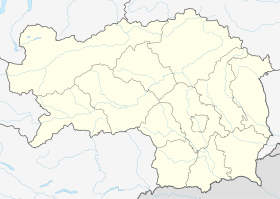
Back Graz Afrikaans Graz ALS ግራጽ Amharic Graz AN غراتس Arabic جراتس ARZ Graz AST Qrats Azerbaijani قراتس AZB Грац Bashkir
Graz | |
|---|---|
| Coordinates: 47°04′15″N 15°26′19″E / 47.07083°N 15.43861°E | |
| Country | |
| Federal state | |
| District | Statutory city |
| Government | |
| • Mayor | Elke Kahr (KPÖ)[1] |
| Area | |
| • Total | 127.57 km2 (49.26 sq mi) |
| Elevation | 353 m (1,158 ft) |
| Population (1 January 2024)[3] | |
| • Total | 303,270 |
| • Density | 2,400/km2 (6,200/sq mi) |
| Demonym(s) | Grazer (en) Grazer (m.) Grazerin (f.) (de) |
| Time zone | UTC+1 (CET) |
| • Summer (DST) | UTC+2 (CEST) |
| Postal code | A-801x, A-802x, A-803x, A-804x, A-805x |
| Area code | +43 316 |
| Vehicle registration | G |
| Website | www.graz.at |
| Official name | City of Graz – Historic Centre and Schloss Eggenberg |
| Criteria | Cultural: ii, iv |
| Reference | 931 |
| Inscription | 1999 (23rd Session) |
| Extensions | 2010 |
Graz (German: [ɡʁaːts] ) is the capital of the Austrian federal state of Styria and the second-largest city in Austria, after Vienna. As of 1 January 2024, Graz had a population of 303,270.[4] In 2023, the population of the Graz larger urban zone (LUZ) stood at 660,238.[5] Graz is known as a college and university city, with four colleges and four universities. Combined, the city is home to more than 60,000 students.[6] Its historic centre (Altstadt) is one of the best-preserved city centres in Central Europe.[7]
In 1999, the city's historic centre was added to the UNESCO list of World Heritage Sites and in 2010 the designation was expanded to include Eggenberg Palace (German: Schloss Eggenberg) on the western edge of the city. Graz was designated the Cultural Capital of Europe in 2003 and became a City of Culinary Delights in 2008.
- ^ Arora, Steffen (13 November 2021). "KPÖ-geführte Linkskoalition stellt ihr "Programm für Graz" vor". Der Standard (in Austrian German). Retrieved 17 November 2021.
- ^ "Dauersiedlungsraum der Gemeinden Politischen Bezirke und Bundesländer - Gebietsstand 1.1.2018". Statistics Austria. Retrieved 10 March 2019.
- ^ "Zahlen + Fakten: Bevölkerung, Bezirke, Wirtschaft, Geografie". Retrieved 30 January 2024.
- ^ "Zahlen + Fakten: Bevölkerung, Bezirke, Wirtschaft, Geografie - Stadtportal der Landeshauptstadt Graz".
- ^ "Population on 1 January by five year age group, sex and metropolitan regions". Eurostat. Retrieved 16 July 2024.
- ^ "Numbers and facts: population, districts, economy, geography (Zahlen + Fakten: Bevölkerung, Bezirke, Wirtschaft, Geografie)" (in German). Graz municipality. 2018. Retrieved 23 November 2019.
- ^ "City of Graz/Stadt Graz". Interreg CENTRAL EUROPE. Archived from the original on 25 June 2022. Retrieved 11 September 2017.








